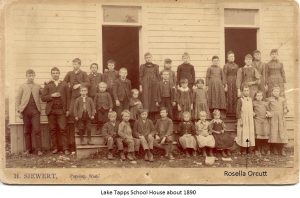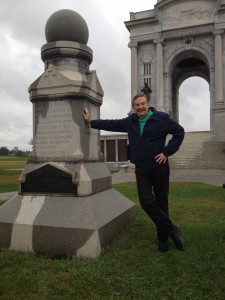My three times great Uncle Alvin Orcutt led a wagon train including twenty seven members of our family west from Kansas in the spring of 1882. By the fall of that year they had settled on the shores of Lake Tapps in Washington Territory. There were only a few other settlers in the area and plenty of available land – so the Orcutt clan staked out 600 prime acres for their homestead. They intended to plant hops, but first the land had to be cleared of trees.
Seeing an opportunity, Uncle Alvin built a steam powered sawmill on part of his land and soon began cutting everyone’s downed timber into finished lumber. His lumber was then used to build the homes and barns of all the other settlers on the plateau.
The tiny community began to grow and within a few years there were over one hundred souls living at Lake Tapps. Life was difficult and the people had to be self-sufficient. The general store, post office, school, church, and even the graveyard were all eight miles away in the town of Sumner – but it might has well have been eighty! Lake Tapps sits on a plateau 500 feet above the valley floor and the only road down the hill to civilization was a dirt track that was all but impassable when it rained … and there is plenty of rain in the northwest.
Uncle Alvin needed a more dependable road to carry his lumber to the railhead in Sumner, so he used some of his logs to “corduroy” the road and make it more weather resistant. That means logs were laid side by side in the dirt to form a bumpy, but more permanent roadbed.
By 1889 Alvin and fellow settler, Amos Crawford decided it was time to civilize their little village, so Amos applied to the US Government and was appointed Postmaster of Lake Tapps. Amos and his wife opened the first post office in their cabin and received mail from Sumner once a week – an advantage over making the eight mile trek to town.
The Lake Tapps School District was formed when Alvin donated one acre of land and the lumber necessary to build a one room school house. It turns out that donation served two purposes, as a Methodist minister began traveling from Sumner every Sunday to hold services in the little school house. Catching the community’s civic spirit, Alvin’s father donated one acre of land to be the community’s cemetery and, in an interesting twist that I will tell about in a future posting, Alvin’s younger brother, Darwin, provided the first body for burial when he shot and killed Bill Cushman in a land dispute.
So how did I find all this information?
• I am very fortunate because Alvin’s daughter, Rosella, wrote her memoir and I have a copy. Rosella recounted tales from the wagon train trek west and how the family settled at Lake Tapps. I used census information from Ancestry.com to verity Alvin lived in Kansas in 1880 and then three years later he lived in Pierce County, Washington Territory. The Bureau of Land Management (blm.gov) has placed old homestead records and survey maps online where I could verify the sections of land held by my family.
• Rosella’s memoir told of the dirt wagon road to Sumner and I found an old picture of a similar track between Sumner and Buckley in the University of Washington’s Special Collections. I used that picture to describe the Lake Tapps road to Sumner.
• In her memoir Rosella told of the post office operating from the Crawford’s cabin and a search of Ancestry turned up the Appointments list of US Postmasters from 1832 to 1971, and that is how I confirmed Amos was indeed the postmaster.
• The Washington State Archives hold all the old land deeds and other recorded legal transactions at their different Regional Archives Branches. The regional archive for Pierce County is one hundred miles from my home, so I took a day trip to visit the archive and was able to find paperwork to confirm my family’s business activities at Lake Tapps. I found Alvin’s transfer of one acre to the Lake Tapps School District and his father’s gift of one acre to Pierce County for a “permanent burying ground”.
• While at the Archives I also found a copy of the 1892 Polk’s Gazetter that described the Lake Tapps community, including Alvin’s saw & shingle mill and the school house with Sunday Methodist church services. Polk’s confirmed there was no general store at Lake Tapps and the nearest town for any such services being Sumner. The Gazetter listed only two residents of importance in Lake Tapps; Amos Crawford, Postmaster and Alvin Orcutt, saw mill operator.

 I don’t want to just find my ancestors; I want to discover their life stories and maybe unwind a few family mysteries along the way. Ancestry.com is great for identifying those long dead relatives, but sometimes the best information is not on line at all, sometimes you have to go looking for an original document in a courthouse or church. I love that kind of search, where my reward is finding a document that has been untouched for over a hundred years.
I don’t want to just find my ancestors; I want to discover their life stories and maybe unwind a few family mysteries along the way. Ancestry.com is great for identifying those long dead relatives, but sometimes the best information is not on line at all, sometimes you have to go looking for an original document in a courthouse or church. I love that kind of search, where my reward is finding a document that has been untouched for over a hundred years.
Recent Comments